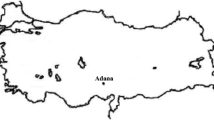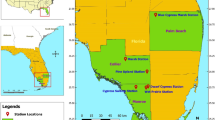Abstract
This study investigates the potential of two evolutionary neuro-fuzzy inference systems, adaptive neuro-fuzzy inference system (ANFIS) with particle swarm optimization (ANFIS–PSO) and genetic algorithm (ANFIS–GA), in modelling reference evapotranspiration (ET0). The hybrid models were tested using Nash–Sutcliffe efficiency, root mean square errors and determination coefficient (R2) statistics and compared with classical ANFIS, artificial neural networks (ANNs) and classification and regression tree (CART). Various combinations of monthly weather data of solar radiation, relative humidity, average air temperature and wind speed gotten from two stations, Antalya and Isparta, Turkey, were used as input parameters to the developed models to estimate ET0. The recommended evolutionary neuro-fuzzy models produced better estimates compared to ANFIS, ANN and CART in modelling monthly ET0. The ANFIS–PSO and/or ANFIS–GA improved the accuracy of ANFIS, ANN and CART by 40%, 32% and 66% for the Antalya and by 14%, 44% and 67% for the Isparta, respectively.

(adapted from d-maps.com)







Similar content being viewed by others
References
Abrishami N, Sepaskhah AR, Shahrokhnia MH (2019) Estimating wheat and maize daily evapotranspiration using artificial neural network. Theoret Appl Climatol 135(3–4):945–958
Adnan RM, Yuan X, Kisi O, Anam R (2017) Improving accuracy of river flow forecasting using LSSVR with gravitational search algorithm. Adv Meteorol 2017:23
Adnan RM, Yuan X, Kisi O, Adnan M, Mehmood A (2018) Stream flow forecasting of poorly gauged mountainous watershed by least square support vector machine, fuzzy genetic algorithm and M5 model tree using climatic data from nearby station. Water Resour Manag 32(14):4469–4486
Adnan RM, Liang Z, Yuan X, Kisi O, Akhlaq M, Li B (2019a) Comparison of LSSVR, M5RT, NF-GP, and NF-SC models for predictions of hourly wind speed and wind power based on cross-validation. Energies 12(2):329
Adnan RM, Liang Z, Trajkovic S, Zounemat-Kermani M, Li B, Kisi O (2019b) Daily streamflow prediction using optimally pruned extreme learning machine. J Hydrol 577:123981
Adnan RM, Malik A, Kumar A, Parmar KS, Kisi O (2019c) Pan evaporation modeling by three different neuro-fuzzy intelligent systems using climatic inputs. Arab J Geosci 12(20):606
Alizamir M, Kisi O, Zounemat-Kermani M (2018) Modelling long-term groundwater fluctuations by extreme learning machine using hydro-climatic data. Hydrol Sci J 63(1):63–73
Alizamir M, Kim S, Kisi O, Zounemat-Kermani M (2020a) A comparative study of several machine learning based non-linear regression methods in estimating solar radiation: case studies of the USA and Turkey regions. Energy 197:117239
Alizamir M, Kim S, Kisi O, Zounemat-Kermani M (2020b) Deep echo state network: a novel machine learning approach to model dew point temperature using meteorological variables. Hydrol Sci J 65(7):1173–1190
Allen RG, Pruitt WO, Wright JL, Howell TA, Ventura F, Snyder R, Itenfisu D, Stedudo P, Berengena J, Yrisarry JB, Smith M, Raes D, Perrier A, Alves I, Walter I, Elliot R (2006) A recommendation on standardized surface resistance for hourly calculation of reference ETo by the FAO 56 Penman–Monteith method. Agric Water Manag 81:1–22
Araghi A, Adamowski J, Martinez CJ (2018) Comparison of wavelet-based hybrid models for the estimation of daily reference evapotranspiration in different climates. J Water Clim Change. https://doi.org/10.2166/wcc.2018.113
Basser H, Karami H, Shamshirband S, Akib S, Amirmojahedi M, Ahmad R, Javidnia H (2015) Hybrid ANFIS–PSO approach for predicting optimum parameters of a protective spur dike. Appl Soft Comput 30:642–649
Breiman L (1984) Classification and regression trees. Chapman & Hall, London
Choubin B, Darabi H, Rahmati O, Sajedi-Hosseini F, Kløve B (2018) River suspended sediment modelling using the CART model: a comparative study of machine learning techniques. Sci Total Environ 615:272–281
Cobaner M (2011) Evapotranspiration estimation by two different neuro-fuzzy inference systems. J Hydrol 398(3–4):292–302
Djavareshkian MH, Esmaeili A (2014) Heuristic optimization of submerged hydrofoil using ANFIS–PSO. Ocean Eng 92:55–63
Ebrahimy H, Azadbakht M (2019) Downscaling MODIS land surface temperature over a heterogeneous area: an investigation of machine learning techniques, feature selection, and impacts of mixed pixels. Comput Geosci 124:93–102
Gocić M, Motamedi S, Shamshirband S, Petković D, Ch S, Hashim R, Arif M (2015) Soft computing approaches for forecasting reference evapotranspiration. Comput Electron Agric 113:164–173
Guven A, Aytek A, Yuce MI, Aksoy H (2008) Genetic programming-based empirical model for daily reference evapotranspiration estimation. CLEAN Soil Air Water 36(10–11):905–912
Hernandez S, Morales L, Sallis P (2011) Estimation of reference evapotranspiration using limited climatic data and Bayesian model averaging. In: Ems, 2011 UK Sim 5th European symposium on computer modeling and simulation. pp 59–63
Jang JS (1993) ANFIS: adaptive-network-based fuzzy inference system. IEEE Trans Syst Man Cybern 23(3):665–685
Juntakut P, Snow DD, Haacker EM, Ray C (2019) The long term effect of agricultural, vadose zone and climatic factors on nitrate contamination in the Nebraska’s groundwater system. J Contam Hydrol 220:33–48
Karterakis SM, Karatzas GP, Nikolos IK, Papadopoulou MP (2007) Application of linear programming and differential evolutionary optimization methodologies for the solution of coastal subsurface water management problems subject to environmental criteria. J Hydrol 342(3–4):270–282
Kennedy J, Eberhart R (1995) Particle swarm optimization. IEEE Int Conf 4:1942–1948
Keshtegar B, Kisi O, Arab HG, Zounemat-Kermani M (2018) Subset modeling basis ANFIS for prediction of the reference evapotranspiration. Water Resour Manag 32(3):1101–1116
Khosravi A, Nunes RO, Assad MEH, Machado L (2018) Comparison of artificial intelligence methods in estimation of daily global solar radiation. J Clean Prod 194:342–358
Kisi O, Alizamir M (2018) Modelling reference evapotranspiration using a new wavelet conjunction heuristic method: wavelet extreme learning machine vs wavelet neural networks. Agric For Meteorol 263:41–48
Kişi Ö, Öztürk Ö (2007) Adaptive neuro fuzzy computing technique for evapotranspiration estimation. J Irrig Drain Eng 133(4):368–379
Kisi O, Sanikhani H, Zounemat-Kermani M, Niazi F (2015) Long-term monthly evapotranspiration modeling by several data-driven methods without climatic data. Comput Electron Agric 115:66–77
Kisi O, Alizamir M et al (2017) Modeling groundwater fluctuations by three different evolutionary neural network techniques using hydroclimatic data. Nat Hazards 87(1):367–381
Kisi O, Shiri J, Karimi S, Adnan RM (2018) Three different adaptive neuro fuzzy computing techniques for forecasting long-period daily streamflows. In: Roy SS et al (eds) Big data in engineering applications. Springer, Singapore, pp 303–321
Kisi O, Alizamir M, Docheshmeh Gorgij A (2020) Dissolved oxygen prediction using a new ensemble method. Environ Sci Pollut Res 27:9589–9603
Ladlani I, Houichi L, Djemili L, Heddam S, Belouz K (2012) Modeling daily reference evapotranspiration (ET0) in the north of Algeria using generalized regression neural networks (GRNN) and radial basis function neural networks (RBFNN): a comparative study. Meteorol Atmos Phys 118(3–4):163–178
Ladlani I, Houichi L, Djemili L, Heddam S, Belouz K (2014) Estimation of daily reference evapotranspiration (ET0) in the north of Algeria using adaptive neuro-fuzzy inference system (ANFIS) and multiple linear regression (MLR) models: a comparative study. Arab J Sci Eng 39(8):5959–5969
Luo Y, Traore S, Lyu X, Wang W, Wang Y, Xie Y, Fipps G (2015) Medium range daily reference evapotranspiration forecasting by using ANN and public weather forecasts. Water Resour Manag 29(10):3863–3876
Majhi B, Naidu D, Mishra AP, Satapathy SC (2019) Improved prediction of daily pan evaporation using deep-LSTM model. Neural Comput Appl. https://doi.org/10.1007/s00521-019-04127-7
Mamdani EH, Assilian S (1975) An experiment in linguistic synthesis with a fuzzy logic controller. Int J Man Mach Stud 7(1):1–13
Mantoglou A, Papantoniou M, Giannoulopoulos P (2004) Management of coastal aquifers based on nonlinear optimization and evolutionary algorithms. J Hydrol 297(1–4):209–228
Muhammad Adnan R, Yuan X, Kisi O, Yuan Y, Tayyab M, Lei X (2019) Application of soft computing models in streamflow forecasting. In: Proceedings of the institution of civil engineers-water management. Thomas Telford Ltd., vol 172(3), pp 123–134
Nair A, Singh G, Mohanty UC (2018) Prediction of monthly summer monsoon rainfall using global climate models through artificial neural network technique. Pure appl Geophys 175(1):403–419
Nourani V, Baghanam AH, Adamowski J, Kisi O (2014) Applications of hybrid wavelet–artificial intelligence models in hydrology: a review. J Hydrol 514:358–377
Patil AP, Deka PC (2017) Performance evaluation of hybrid wavelet-ANN and wavelet-ANFIS models for estimating evapotranspiration in arid regions of India. Neural Comput Appl 28(2):275–285
Rezakazemi M, Dashti A, Asghari M, Shirazian S (2017) H2-selective mixed matrix membranes modeling using ANFIS, PSO-ANFIS, GA-ANFIS. Int J Hydrog Energy 42(22):15211–15225
Rumelhart DE, Hinton GE, Williams RJ (1986) Learning internal representation by error propagation. In: Rumelhart DE, McClelland JL (eds) Parallel distributed processing, vol 1. MIT, Cambridge
Sayed T, Tavakolie A, Razavi A (2003) Comparison of adaptive network based fuzzy inference systems and b-spline neuro-fuzzy mode choice models. J Comput Civ Eng ASCE 17(2):123–130
Shamshirband S, Amirmojahedi M, Gocić M, Akib S, Petković D, Piri J, Trajkovic S (2016) Estimation of reference evapotranspiration using neural networks and cuckoo search algorithm. J Irrig Drain Eng 142(2):04015044
Tabari H, Kisi O, Ezani A, Talaee PH (2012) SVM, ANFIS, regression and climate-based models for reference evapotranspiration modeling using limited climatic data in a semi-arid highland environment. J Hydrol 444:78–89
Takagi T, Sugeno M (1985) Fuzzy identification of systems and its applications to modeling and control. IEEE Trans Syst Man Cybern 15:116–132
Termeh SVR, Kornejady A, Pourghasemi HR, Keesstra S (2018) Flood susceptibility mapping using novel ensembles of adaptive neuro fuzzy inference system and metaheuristic algorithms. Sci Total Environ 615:438–451
Tsukamoto Y (1979) An approach to reasoning method. In: Gupta M, Ragade RK, Yager RR (eds) Advances in fuzzy set theory and applications. Elsevier, Amsterdam, pp 137–149
Walls S, Binns AD, Levison J, MacRitchie S (2020) Prediction of actual evapotranspiration by artificial neural network models using data from a Bowen ratio energy balance station. Neural Comput Appl. https://doi.org/10.1007/s00521-020-04800-2
Wen X, Si J, He Z, Wu J, Shao H, Yu H (2015) Support-vector-machine-based models for modeling daily reference evapotranspiration with limited climatic data in extreme arid regions. Water Resour Manag 29(9):3195–3209
Wu L, Huang G, Fan J, Ma X, Zhou H, Zeng W (2020) Hybrid extreme learning machine with meta-heuristic algorithms for monthly pan evaporation prediction. Comput Electron Agric 168:105115
Yuan X, Chen C, Lei X, Yuan Y, Adnan RM (2018) Monthly runoff forecasting based on LSTM–ALO model. Stoch Environ Res Risk Assess 32(8):2199–2212
Zhu S, Heddam S et al (2019) Modeling daily water temperature for rivers: comparison between adaptive neuro-fuzzy inference systems and artificial neural networks models. Environ Sci Pollut Res 26(1):402–420
Acknowledgement
The authors would like to thank the anonymous reviewers for their valuable comments and suggestions to improve this manuscript further. Alban Kuriqi was supported by a Ph.D. scholarship granted by Fundação para a Ciência e a Tecnologia, I.P. (FCT), Portugal, under the Ph.D. Programme FLUVIO–River Restoration and Management, grant number: PD/BD/114558/2016.
Author information
Authors and Affiliations
Corresponding author
Ethics declarations
Conflict of interest
There is not any conflict of interest in this study.
Rights and permissions
About this article
Cite this article
Alizamir, M., Kisi, O., Muhammad Adnan, R. et al. Modelling reference evapotranspiration by combining neuro-fuzzy and evolutionary strategies. Acta Geophys. 68, 1113–1126 (2020). https://doi.org/10.1007/s11600-020-00446-9
Received:
Accepted:
Published:
Issue Date:
DOI: https://doi.org/10.1007/s11600-020-00446-9




